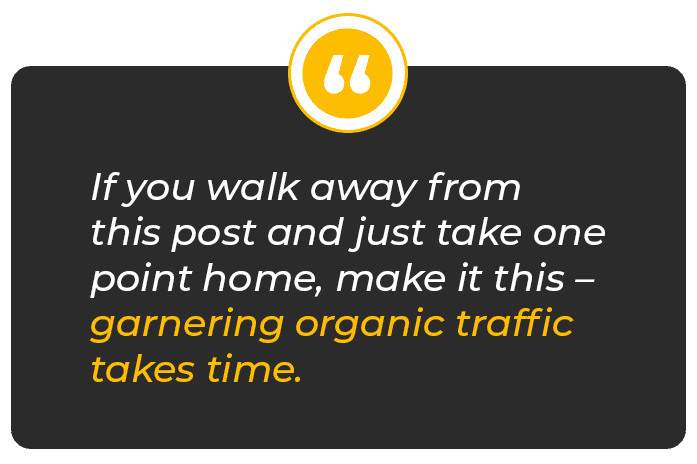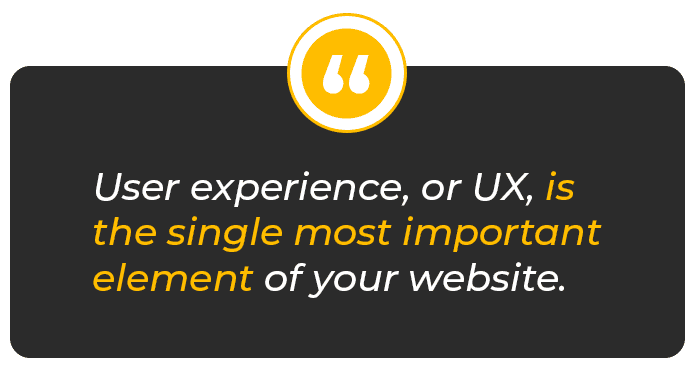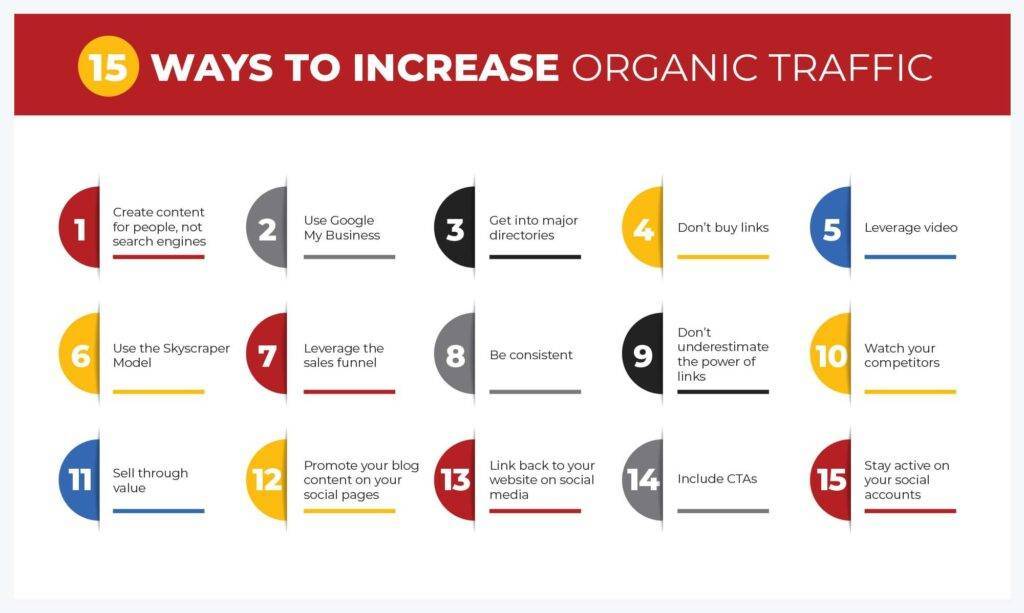Table of Contents
Your website is only a tiny piece of the traffic equation. It doesn’t matter if you’ve built the most intuitive, customer-centric, flashy website on the planet. It won’t magically bring your audience to you because, well, that’s just not how this works.
But before we get into the tips on how to increase organic traffic …
What is Organic Traffic?
Organic search traffic results from users finding a website through a search engine such as Google, Yahoo, or Bing.
What Does an Increase in Organic Traffic Mean?
An increase in organic traffic means that your website receives more traffic from users who find your site through search engines, as opposed to paid advertising or other promotional methods.
All in all, an increase in organic traffic is a good thing. It shows that your site is relevant and useful to users and is being rewarded by Google because it’s showing up in the search engine result pages (SERPs).
Three Hidden Truths of Traffic
There are three hidden truths of traffic that you need to know …
Organic Traffic is a Long Game
Not a month or two, but it’ll be at least six to 12 months before you see significant traffic returns.
That’s because it takes time to rank on search engines and you must create content to keep people coming back. Only a few websites see results in a couple of months, and they’re the exception, not the rule.

Website Traffic Requires Trial and Error
You’re going to fail. A lot. Search engine optimization (SEO) is not easy.
There are so many factors that play into developing a strategy and tactical execution. Couple that with a fast-paced landscape you need to be ready to adjust your strategies on a whim.
Your new Facebook ad may not work, or your newly published blog may not be appealing. So, you have to be willing to abandon some of your strategies, despite if they’ve worked in the past if they’re not working now.
You Can’t Buy Traffic
Well, you can buy traffic. It’s expensive, but the sticking point is you can’t buy quality traffic.
If you want a landslide of quality traffic, build up your organic content and stick to proven strategies to earn it. Paid ads are like a booster shot for traffic, but they aren’t consistent enough to be your primary traffic source.
Creating solid, thorough, well-thought-out content is the only surefire way to increase your organic traffic.
Technical SEO for Your Website
Before we get into ways to increase your organic traffic, you’ll want to check on your core web vitals and technical aspects of your website.
If these aren’t where they need to be, it doesn’t matter how strong your SEO strategy is. Traffic won’t come unless you have a solid foundation.
There are five components of a well-functioning website:
User Experience
UX comes down to the way users interact with your website. It includes your user interface and template design but comes all the way down to how you structure your content, link structure, and everything else on the site.
It’s hard work to make every interaction on your website intuitive but you need to keep it in the forefront of your mind because 97 percent of B2B customers say usability is the most essential quality for websites and mobile apps.

Speed
Speed is yet another imperative factor of your website.
So imperative that 79 percent of people leave a website and never return if it takes too long to load, so the speed is a big deal.
Folks want reliable websites, and it doesn’t help that our attention spans are about as short as a goldfish. Not only are slow websites annoying, but they kill impulse buying — something you want to keep.
Mobile-Friendliness
“Mobile first” is a common phrase for a reason. Most internet traffic comes from phones, so Google uses a mobile-first indexer.
Repeat after me: desktop comes second. Mobile is king, so build your website around mobile usability.
Design
Humans are visual creatures. We can identify an image in as little as 13 milliseconds, so if we don’t like it, we leave.
We love things that look appealing, so make your website pretty and keep it functional.
SSL
SSL stands for Secure Sockets Layer, a security protocol that creates an encrypted link between a web server and a web browser. Companies and organizations use SSL certificates to secure online transactions and keep customer information private and secure.
Recognize the HTTPS sign you see next to the most credible websites? That’s the SSL.
You need SSL, and it’s easy to set up through your domain host. And if you don’t have one, Google will mark your site as unsafe. That destroys your credibility and traffic potential.

Ways to Increase Organic Traffic
Now that we have the technical aspects addressed, here is how you can drive organic traffic to your website …
1. Create Content for People, Not Search Engines
If your website is the engine that powers your digital efforts, your content is the fuel. Content will drive traffic to your site like nothing else — consistently and with purpose.
Even though SEO-focused content is critical, content is not all about search engines. You must build your content for people, not search engines. This is especially relevant with the Google helpful content update.
Do this instead: put out killer content that people like. It’s that simple.
Think about the value of the content you put out, not rank. Resist the urge to chase keywords that rank well. Instead, focus on keywords you want to be associated with, and your customers will get value from it.
That’s not to say that you won’t have to get analytical. You definitely will. But think about your content by what your user gets from it, not your brand.
2. Use Google My Business
Sign up for Google My Business, so your company has a snapshot profile right in Google. And it’s really important for brick-and-mortar businesses, too. Think of the right-hand results that show reviews and contact info when you Google “Panda Express near me.” That’s Google My Business in action. It’s free to sign up and is a quick process. Plus, Google My Business is a necessity to make it into local pack listings.
3. Get into Major Directories
There are tons of online directories, and they work like this (no brain buster on this one): Sign up and get free traffic.
Think Apple Maps, FourSquare, or Yelp. Here’s a starter directory list. It all amounts to signing up for websites with tons of domain authority and using their traffic to send traffic vibes your way.
4. Don’t Buy Backlinks
If you’ve stumbled onto less-than-genuine marketing blogs, you’ve probably seen posts about buying links.
Do. Not. Do. This.
Black hat SEO will come back to bite you. How? Google will penalize your website so hard that you’ll never rank again
5. Leverage Video
If videos aren’t part of your content, and you’re not on YouTube you’re making a mistake. You grow 49 percent faster with video than with written content.
That’s why half of marketers think videos give the best ROI. But it’s hard to work videos into every piece of content.
Here’s the trick: you don’t have to post high-quality videos every time. It’s okay to go low budget here and there. Actually, low-budget often outperform high-budget videos, especially if they feel rustic and personal.

6. Use the Skyscraper Model
Brian Dean from Backlinko uses the skyscraper technique. First, find competitor (or non-competitor) content that ranks well. Use that as inspiration to create similar content that’s twice as good. After, share it on your social accounts and wait for results.
Seems too simple, right?
Well, if you consistently make better content than your competitors, you’ll drive tons of traffic to your website. Of course, you have to commit to creating best-of-breed content every. Single. Time. And if you pull it off, you’ll rank well and reap the benefits.
7. Leverage the Sales Funnel
Never forget about your sales funnel. Instead, make a point to start using it.
Think about the content your customers want at each stage in the funnel. Don’t just churn out introductory content. Some of it should be mid-funnel and bottom-funnel.
Blog posts are good starters, but go further and create whitepapers, eBooks, and webinars that appeal to more informed customers.
8. Be Consistent
Schedules help you in life, so why wouldn’t they help your website? It doesn’t matter if you post once a day or once a week but do it consistently and on the same timeframe.
Customers grow to expect it, and you’ll develop a habit of creating content — which helps in the first few months when you’re not ranking well.
9. Don’t Underestimate the Power of Links
Google wants you to link in your posts. Stack both internal (your blog) and external (anything that’s not your blog) links in each post. External links back up your claims, and the internal links logically guide users to your other posts.
10. Watch Your Competition
Creating killer on-page content requires you to keep an eye on your competitors.
What kinds of posts are they making? What keywords are they targeting? How could you do it better?
Watch what they do, and always make your content better.
11. Sell Through Value
Don’t make your blog about your business. This is a common mistake with serious traffic consequences.
Make posts about value, not about how great your business is. Leave the sales pitch to that department.
Small sales efforts are fine, like building an email list and plugging a call-to-action (CTA), but don’t spend every post discussing how well your company solves problems.
12. Promote Your Blog Content on Your Social Pages
Easy peasy. Use social media, generate a following and share blog content that redirects to your website. What’s even better is that you’re tapping into your follower base to generate more website visitors.
13. Link Back to Your Website on Social Media
Let’s say you use LinkedIn to grab B2B prospects. Your profile won’t live up to its potential if it doesn’t show visitors where your website is, though, so drop in your URL to snag that engagement and traffic.
14. Include CTAs
Whether you’re sharing videos, eBooks, articles, or whatever else, ensure there is a CTA to link back to your site in the body of your content. Then, when you spread it around social media, the most-interested prospects will follow your CTA back to your website.
15. Stay Active on Your Social Accounts
You must be active on social.
Posting, sharing, commenting, answering questions, and engaging with your followers counts. Social media is its unique hub. Use it to generate site traffic, get leads, or both.
Put in the Hard Work for Website Traffic
You won’t get a steady traffic flow on your new website in a day. It’s a long-term investment and can take months (even years) before you start generating quality traffic. But between social media, your website, and your content, you can get a head start with the fundamental traffic drivers to increase organic traffic.
And, if you need help with your strategy, RedShift SEO Services can make your life a lot easier. Contact us about our SEO services today!



